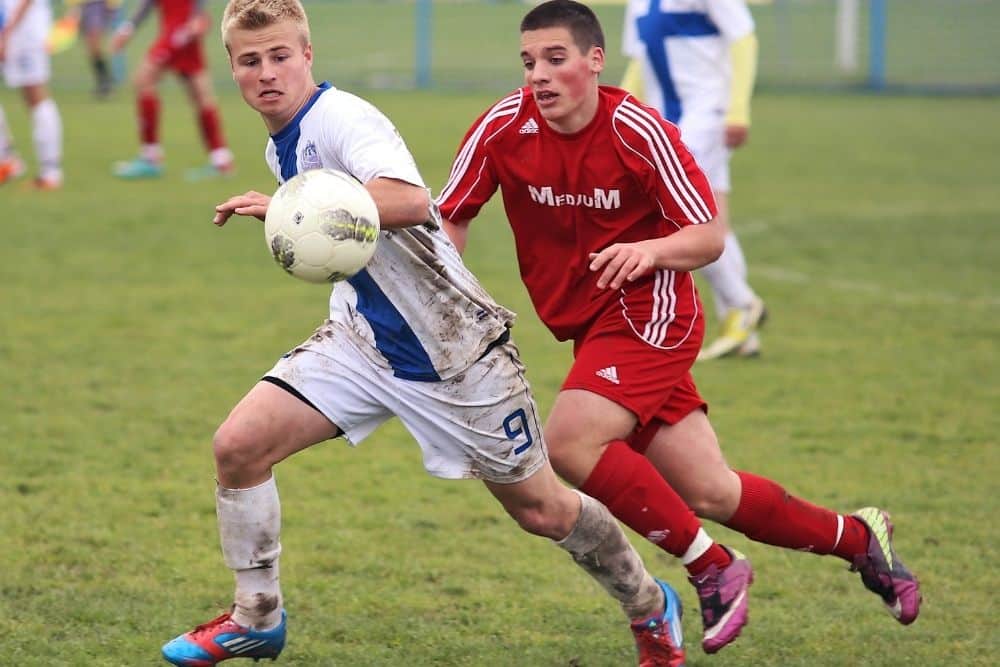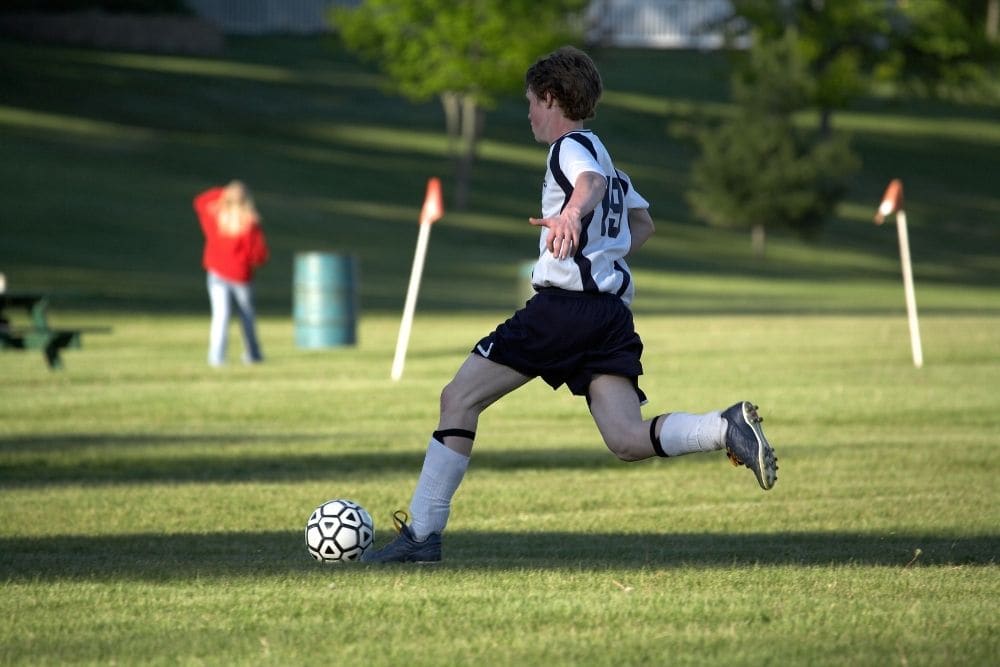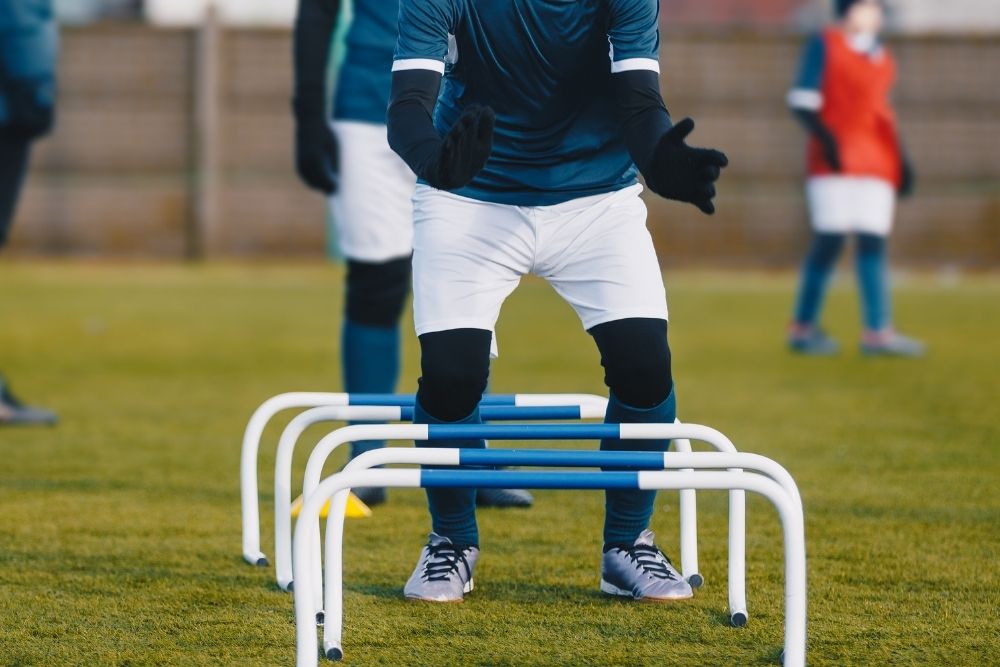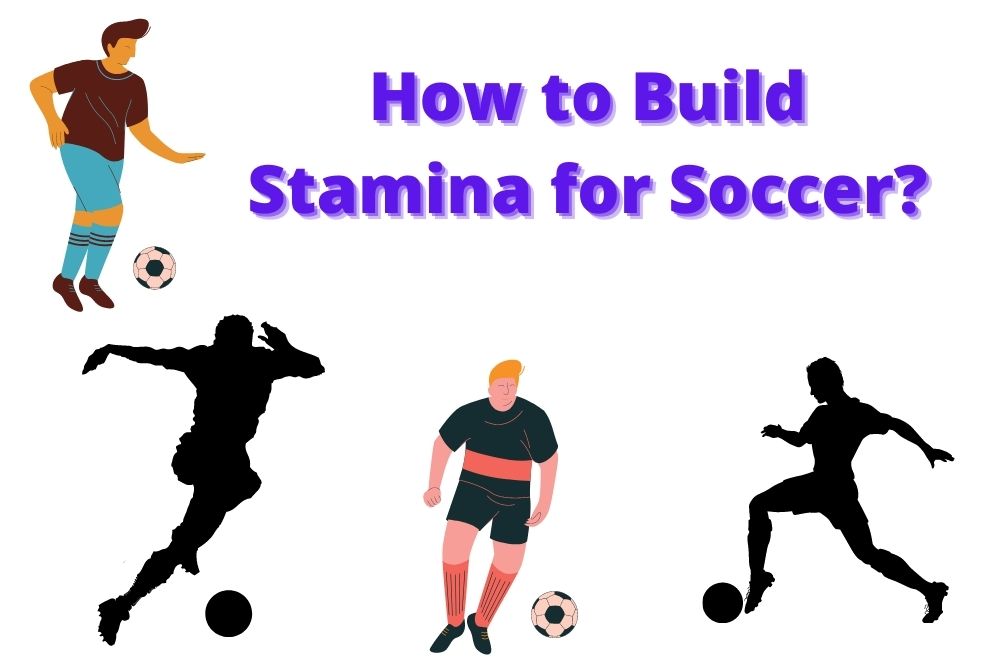Soccer is a team sport that requires quick reactions, speed, and stamina. Because of the fast-paced nature of the game, conditioning is essential.
Soccer players benefit from agility training since they must constantly shift directions. In addition, stretching and hydration are critical when playing soccer to avoid injuries, cramping, and muscle sprains.
One of the most crucial factors of soccer play is physical conditioning. A skilled player will go far in the sport, but they will not be a solid player without the fitness component.
One of the most significant physical fitness traits for soccer players is maximal aerobic fitness. Throughout the 90-minute game, players must maintain a high level of intensity.
Another crucial fitness component is anaerobic fitness, which refers to running speed and, more specifically, repeat sprint performance. Players must also be agile, strong, powerful, and flexible.
Soccer is a total-body activity, and a soccer player’s body must work as a whole. While running, every component of a soccer player’s body is vital.
A soccer player must move their body forward while maintaining balance, improving total speed, and this is only feasible if the player has stamina.

Disregarding upper-body force and stamina can adversely influence a soccer player’s overall development, reducing the ability to attain top speed and change directions fast. This also applies to every other part of a soccer player’s body.
That’s because ground reaction forces, or forces from the ground, flow up each leg, through to the core, and over the upper body with each stride you take.
Furthermore, today’s best soccer matches are growing more violent, with players continually pushing and tugging with their upper bodies to achieve position against one another.
Upper-body strength training is an essential component of any program for improving your entire skillset.
Furthermore, soccer is not only about talent and technique. It is about more than just speed. It’s also about power. Soccer players will never be complete until they improve on their strength.
Some may regard soccer as a “running” sport wherein stamina training is essential. Strength training, sometimes known as weight training, conjures up ideas of huge muscles that might slow a player down.
Soccer is a tremendously physical sport in which a player’s success winning tackles, out-muscling opponents one-on-one, and properly positioning oneself to control a ball in the air is determined by strength. Therefore, being stronger than your opponents gives you a significant edge.
Quick Navigation
- How to build stamina for soccer?
- Have some specific Exercises to Perform
- Use a combination of rapid runs and short pauses
- Engage in some controlled anaerobic exercise
- Carry out Interval training
- Cycling
- Work out with resistance bands
- Get proper sleep, drink more water, and eat good food
- Psychological Visualization
- Move past negative emotions
- Do soccer players have good stamina?
- Conclusion
How to build stamina for soccer?
Stamina is very important for every soccer player. So in this part of this article, ways by which every soccer player can build strength for the game will be extensively discussed.
Have some specific Exercises to Perform
Cardiovascular activity should be prioritized. For example, a soccer player will need to exert a lot of cardiovascular energy as it is necessary.
Developing the stamina required for a complete match needs a frequent and intense aerobic workout. This will allow you to run and pass the ball for more than an hour and a half.
According to the research carried out in the year 1997, the typical player spends 40 to 60 minutes every game running or jogging. This implies you won’t be running about the entire time; therefore, you won’t need to train for 90 minutes of endurance.
The cardiovascular activities you engage in, such as running or jogging, should ideally last 30 to 60 minutes per session.
If soccer players want to improve their endurance, they should utilize a heart rate monitor to ensure that they are using the appropriate amount of energy for the workout.
A soccer player ought to have a heart rate between 65 and 85 percent of their maximal heart rate for endurance development, and the bulk of the workout should keep their heart rate between 65 and 70 percent.
This range aids in the growth of oxygen transport, volume of blood, as well as capillary density.
Use a combination of rapid runs and short pauses
Although cardiovascular exercise is important for building human stamina, it is especially important for soccer players.
The key to increasing endurance is to alternate between short bursts of high-intensity activity and short rest periods. Sprinting, for example, will assist soccer players in preparing for around 10 to 15% of their games.
To increase a soccer player’s sprinting, they should perform 10 to 15 sets of 20-yard dashes with a 30-second break in between to adapt their body to swiftly beginning and stopping.
A soccer player may also use this approach to develop dribbling. They should dribble the ball for 30 to 40 yards, then drop the ball and sprint another up to 50 yards swiftly.
They should then spin around, run back to the ball, and dribble it up to 50 yards farther. They should also rest for a minute to two minutes before performing five additional reps.
This can assist a soccer player in fast transitioning from dribbling the ball to sprinting independently. In addition, this will prevent the soccer player from tripping over a ball during the game.
Trips and falls are the main sources of legal responsibility for many training centers; therefore, it is critical to be extra cautious with these activities.
A soccer player should practice jogging around the field at various speeds on each side to improve on swiftly shifting speeds. For example, they should run one side at about full speed before slowing down to a jog for the next.
They can also accelerate to medium speed, then accelerate to full speed on the final side, then jog again. The soccer player can try this exercise over again, and it is very beneficial.
This training, which focuses on fast adjusting the soccer player’s movements, will assist them in adapting to the continuously changing physical aspects of a soccer match.

Engage in some controlled anaerobic exercise
Anaerobic training involves rigorous muscular activity to improve strength and power. Anaerobic exercise is known to be an intensive one.
Aerobic exercise helps to generate energy by making use of a steady oxygen supply to maintain the current activity level without the need for more energy from a different source. However, anaerobic exercise causes the soccer player’s body to demand more energy than their aerobic system can supply.
The body’s anaerobic system, which relies on sources of energy retained in the muscles, is used to generate more energy.
Aerobic exercise includes slower-paced activities such as running or endurance cycling. Sprinting, high-intensity interval training (HIIT), jumping rope, and interval training are examples of fast-paced workouts that emphasize anaerobic exercise.
According to Exercise Consultants, anaerobic glycolysis, an energy pathway that creates lactic acid as a metabolic byproduct, fuels the fast, high-intensity sprints necessary to move the ball down the field.
Lactic acid accumulation can disrupt muscle mechanics, resulting in a reduction in force output and velocity. Speed training can minimize early lactate production and increase the pace at which lactic acid is cleared from the muscles.
As opposed to quickness training, speed training involves lengthier intervals ranging from 30 seconds to three minutes, with only 90 seconds of sub-maximal recovery between intervals. This anaerobic exercise is one of the necessary exercises for every soccer player.
It is advisable to engage in anaerobic exercise as a soccer player because it helps in increasing the stamina level of players or anyone who engages in it.
Though, the anaerobic exercise should be engaged at a controlled level. Soccer players might injure themselves during sections of anaerobic exercise. A lot of professional soccer players are a victim of getting injured while having their training sections, mostly anaerobic training.

Carry out Interval training
Interval training will considerably improve a player’s soccer abilities. This is when they switch between activity levels throughout a workout.
This will allow their heart rate to recover regularly. The ideal circuit training alternates between extremely low energy activity (a moderate jog) and bursts of highly energetic exercise.
This allows a soccer player’s muscles to be exercised and conditioned without undue tension. It also aids in pushing their physical ability to enhance strength or speed without causing undue wear and tear.
Top athletes adhere to the 80/20 exercise guideline, which states that 80 percent of their workout should be moderate, while the remaining 20 percent should be medium to high.
When preparing for soccer, the best thing a soccer player can do is teach their body to respond to fast-changing surroundings. Throughout the game, they will be jogging, running, dribbling, pacing, and standing from one point to the other on the soccer pitch.
Instead of embarking on a cross-country run, they can train by teaching their body to switch between different tasks swiftly and easily. This can enable them to stay in the game for the length of time of their next match.
Cycling
A bike might be one of the most important pieces of training equipment for any soccer player. Cycling can help a soccer player run faster, increase muscular strength, and recover faster.
Cycling improves running performance by increasing fitness, stamina, and endurance without causing leg muscle damage. It’s also a wonderful low-impact cardiovascular workout.
It’s also a wonderful low-impact cardiovascular workout, and including it into any soccer player’s weekly training routine will allow them to do more with less strain on their body.
When soccer players run, they develop certain muscle groups to accomplish specific duties. As a result, they will first feel terrific as they gain strength.
However, if a soccer player’s training consists solely of jogging, they will become accustomed to it and would most likely cease seeing improvements. That may be aggravating.
Cycling employs a different set of muscles than running, including greater utilization of the quadriceps, glutes, and core muscles. These muscles will supplement those utilized for running, making them stronger soccer players.
Efficiency should also increase, which will benefit the soccer player’s performance on the field. For example, to increase strength, ride your bike uphill in high gear.
Cycling through very beneficial to give strength, sharpness, and efficiency should be done at a minimal rate. For example, when done at a time closer to the soccer match time by a player, cycling is not a good idea.
Cycling promotes recovery by boosting blood flow to the calves, quadriceps, glutes, and hamstrings, which flushes away lactic acid and assists in their regeneration. The action will also help to alleviate muscle and joint stiffness.
Being injured is a devastating blow, and taking a vacation from soccer might sometimes be required to allow a soccer player’s body to recuperate.
Cycling for soccer players should be done at a minimal rate and in a good environment where the chances of soccer players getting injured while cycling is reduced.
If a soccer player on high terrain does cycling, it might help build more lower-body muscle, and this always accompanies pains in the thighs.
Work out with resistance bands
Resistance band workouts have several advantages. Bands not only help to increase muscle strength but also provide a low-impact training alternative to weight lifting.
Including band workouts in your endurance training will help you improve your technique and efficiency, reduce injury, and strengthen your bones.
With the use of resistance bands, a soccer player may successfully target various muscle groups with a single workout. Bands also are a wonderful alternative for prompt workouts.
There are several methods to work out using resistance bands. Soccer players might attempt the following exercises to increase their stamina.
Step into a looped band on the floor, with the band extending beneath both feet. To begin, raise both hands to chest level, keeping your elbows high and out.
Then, externally rotate and forward lift the arms. This workout focuses on the shoulders and is periscapular.
Step inside with your feet shoulder-width apart in an athletic stance and a looped band on the ground. Tension may be changed by holding the band.
Step laterally with one foot, remaining low, and let the opposing foot follow. Attempt to maintain the band taut between steps. This exercise targets the glute meds as well as the abductor’s muscle.
Lie on the floor with the band at ankle level. Flex your knees, bringing your ankles near your buttocks. Move away from the tethered band to change the resistance. The hamstrings are the focus of this workout.
Lie supine with the band at knee level, and your hips and knees flexed at 90 degrees. Wrap the band over your foot like a stirrup. Alternate legs, flexing the hip to the chest, then repeat with the opposing leg. This workout focuses on the Iliopsoas.
Step the left ankle into the band and stand with the band to your left, with the band at ankle level. Next, take a few steps backward from the anchor to tighten the band and keep your feet shoulder-width apart.
Adduct the left leg such that the ankles contact while keeping the right leg motionless and Rep on the other side.
Bring the left ankle from the stretched position to the front of the body, facing the band to the back, with the left ankle in the band loop and the right leg immobile—Rep on the other side.
This workout focuses on the abductors, hamstrings, hip flexors, and quads.
- 【Superior Quality】- being able to train anywhere you want. With MHIL's booty bands, you'll...
- 【Multiple Resistance Levels】- Our unique package comes with 5 different bands, all the same...
- 【Shape up】- with our exercise bands resistance bands set, working to help you lose weight and...
Last update on 2023-11-10 / Affiliate links / Images from Amazon Product Advertising API
Get proper sleep, drink more water, and eat good food
It is a very obvious thing in life. Good food, water, and sleep are what fuel the body. The better a soccer player fuels their body, the better it performs.
Doing this will build in any soccer player good health. It is only a healthy player that can perform better. So above any workout, a soccer player should pay utmost attention to this.
Soccer players should avoid eating junk and taking any substances that can deteriorate their health. Instead, soccer players should prioritize taking a lot of protein and vitamins. This is because these classes of food help build the body and help the body’s immune system.
There is no disadvantage to eating, drinking a lot of water, and sleeping. On the contrary, it helps the body a lot. It supplies the body with the freshness required for every match.
Psychological Visualization
The mind’s power should not be undervalued, particularly the strength of what you believe you can or cannot do. For example, if a soccer player believes his team will lose the game, they will likely lose the game!
Learn to envision yourself succeeding on the soccer field and utilize that confidence to urge yourself ahead. Imagine yourself returning to the field at halftime, playing good football, making solid tackles, saving your team, and doing a variety of other positive things to improve your game.
Move past negative emotions
It goes without saying that optimism is preferable to negativity. Anxiety is a natural component of athletic competition.
It can even drive soccer players to improve their performance; nevertheless, if it becomes a hindrance to any soccer player, they will be unable to move past the crippling fear of failing.
Perhaps it’s necessary to practice some coping techniques (such as mindfulness, relaxing your nerves, taking deep breaths, or fore-thinking).
Family and friends of every human are always reasons why many try to give their best. So having them around in a soccer match might be a proper way of getting rid of anxiety and every negative emotion.
A soccer player can psychologically prepare for a match and also build stamina by having them around.
This does not only help the confidence and strength level of a soccer player; it also helps their match focus.
A company of people who believes in any individual helps the performance of such individuals. It is not a bad idea if soccer players, therefore, surround themselves with people who believe in them.
Do soccer players have good stamina?
Most soccer injuries result from a lack of stamina in places like the knee, hamstrings, ankle, and many other parts of the player’s body. So that gives us the answer that soccer players require a good level of strength.
Considering a popular soccer player, Cristiano Ronaldo, the answer to this question will be yes. He has exemplified how a soccer player should be. Very healthy and strong! For a successful career, a soccer player needs to be very strong.
The game of soccer is known for its contesting spirit. As a player, it is necessary to contend with the opponent. As a defender, a soccer player will contend with the opposing team’s striker. As a winger, a player will contend with the full-backs. Therefore, the contest requires every player to be strong.
However, this does not mean that all soccer players are at a very strong stamina level. For instance, when you consider soccer players like Santiago Carzola, who had great talent and skill but had an awful career towards the end of his contract with Arsenal due to different injuries.
He could have been at another level in his career, but he retarded due to his low stamina level. This suggests that soccer players need stamina, and those who do not have it will eventually risk the chance of a career-ending injury.
Conclusion
Soccer is a physical game, and it requires the players to be strong and healthy. However, a soccer player cannot be referred to as complete if they are not strong.
But strength in soccer can be built. And different workouts can help bring this to fruition. Workouts like cycling, interval workout, the use of resistance bands, and many more will help a soccer player to build a good stamina level.
Feeding well and having a good rest (sleep) can also contribute to building a good strength level for a soccer player. Players like Cristiano Ronaldo modeled a good legacy of building a good stamina level as a soccer player.
Hi there, I’m Jay.
Soccer is everything in my life! My friends and I have created this blog with all our enthusiasm, passion, and understanding after years of playing pro soccer. Hope you will enjoy it!

